|
|
 |
|
Calanoida ( Order ) |
|
|
|
Calanoidea ( Superfamily ) |
|
|
|
Paracalanidae ( Family ) |
|
|
|
Paracalanus ( Genus ) |
|
|
| |
Paracalanus indicus Wolfenden, 1905 (F,M) | |
| | | | | | | Syn.: | Paracalanus parvus (part.) Claus,1863;
Paracalanus parvus indicus Wolfenden, 1905 (1906) (p.998, figs.F);
Paracalanus parvus : Giesbrecht, 1892 (part., p.164, figs.F,M); Giesbrecht & Schmeil, 1898 (part., p.24); Farran, 1929 (p.221: part.); ? Sewell, 1912 (p.358); Sewell, 1929 (p.68, figs.F,M); ? Dakin & Colefax, 1933 (p.204); 1940 (p.93, figs.F,M); Mori, 1929 (p.171, Figs.F,M); 1937 (1964) (p.29, figs.F,M); ? Sewell, 1947 (p.51); ? Tanaka, 1956 c (p.369, Rem.F,M); ? Corral Estrada, 1970 (Pl.13); Bradford, 1972 (p.34, figs.F,M, Rem.); ? Hsieh & al., 2004 (p.397, tab.1); ? Razai & al., 2004 (p.489, tab.2, p.495, tab.8); ? Lo & al.*, 2004 (p.218, fig.6); ? Lo & al., 2004 (p.468, tab.2);
Acrocalanus indicus : Zhang G.-T. & Wong, 2011 (p.277, fig.6, 7, abundance, indicator) | | | | Ref.: | | | Bowman, 1971 b (p.24, figs.F,M, Rem.); Björnberg, 1973 (p.304); Andronov, 1977 (p.155, fig.F); , Rem.); Bradford, 1978 (p.135, figs.F, M, Rem.); Björnberg & al., 1981 (p.604, 624, figs.F); Campaner, 1985 (p.10); 1986 (p.261); Bradford, 1985 (p.316, 320); Foster & Battaerd, 1985 (p.213); Hiromi, 1987 (p.147, 153, 155, Rem.); Nishida, 1989 (p173, Table 1, 2, 3: dorsal hump); Bradford-Grieve, 1994 (p.67, figs.F,M, Rem., fig.99); Kang, 1996 (p.409, figs.F, Rem.); Bradford-Grieve & al., 1999 (p.878, 910, figs.F,M); Barthélémy, 1999 a (p.10, Fig.19, F, I); Boxshall & Halsey, 2004 (p.152, M); Vives & Shmeleva, 2007 (p.969, figs.F,M, Rem.); Khelifi-Touhami & al., 2007 (327, 329, figs.F,M, tab.1, 3); Kesarkar & Anil, 2010 (Rem.: p.404, fig.5E); Al-Yamani & al., 2011 (p.22, figs.F,M); Cornils & Blanco-Bercial, 2013 (p.861, Table 1, molecular analysis, figs.3, 4, 5) | 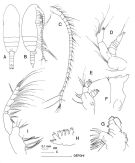 issued from : J.M. Bradford-Grieve in The Marine Fauna of New Zealand: Pelagic Calanoid Copepoda. National Institute of Water and Atmospheric Research (NIWA). New Zealand Oceanographic Institute Memoir, 102, 1994. [p.47, Fig.19]. Female: A, habitus (dorsal); B, idem (left lateral side); C, A1; D, A2; E, Md (mandibular palp); F, Md (mandibular blade); G, Mx1; H, Mx2; I, Mxp. Nota: The female genital segment of New Zealand specimens, unlike Bowman's description, appear to be without postero-lateral spinules and there is a tendency to have fewer spinules on the surfaces of P2-P4.
|
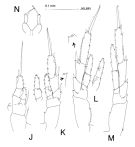 issued from : J.M. Bradford-Grieve in The Marine Fauna of New Zealand: Pelagic Calanoid Copepoda. National Institute of Water and Atmospheric Research (NIWA). New Zealand Oceanographic Institute Memoir, 102, 1994. [p.48, Fig.19 (above)]. Female: J, P1; K, P2; L, P3; M, P4; N, P5.
|
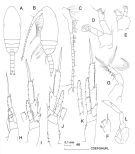 issued from : J.M. Bradford-Grieve in The Marine Fauna of New Zealand: Pelagic Calanoid Copepoda. National Institute of Water and Atmospheric Research (NIWA). New Zealand Oceanographic Institute Memoir, 102, 1994. [p.49, Fig.21) Male: A, habitus (dorsal); B, idem (left lateral side); C, A1; D, A2; E, Md (mandibular palp); F, Mx1; G, Mx2 and Mxp; H, P1; I, P2; J, P3; K, P4; L, P5.
|
 issued from : J.M. Bradford in Jl R. Soc.N.Z., 1978, 8 (2). [p.134, Fig.1]. Female (from Foveaux Strait: S New Zealand): A, habitus (lateral left side); B, idem (dorsal); C, urosome (lateral left side); D, idem (dorsal). Male: E, habitus (lateral left side); F, idem (dorsal); G, urosome (dorsal).
|
 issued from : J.M. Bradford in Jl R. Soc.N.Z., 1978, 8 (2). [p.135, Fig.2]. Female (from Foveaux Strait: S New Zealand): A, P1: B, P2 (psterior view and anterior view of endopod); C, P3 (posterior view and anterior view of endopod; D, P4 ( (posterior view and anterior view of endopod); E, P5.
|
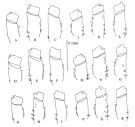 issued from : J.M. Bradford in Jl R. Soc.N.Z., 1978, 8 (2). [p.137, Fig.4]. Variation of ornamentation on basipod 1 (from Western Cook Strait, New Zealand). Females: A, D, G , leg 2; B, E, H, leg 3; C, F, I, leg 4. Males: J, M, P, leg 2; K, N, Q, leg 3; L, O, R, leg 4.
|
 issued from : J.M. Bradford in Jl R. Soc.N.Z., 1978, 8 (2). [p.136, Fig.3]. Male (from Foveaux Strait, New Zealand): A, P1; B, P2 (posterior view); C, P3 (idem); D, P4 (idem); E, P5 (anterior view).
|
 issued from : R.B.S. Sewell in Mem. Indian Mus., 1929, X. [p.69, Fig.24]. As Paracalanus parvus. Female (from N Indian): a, genital segment (ventral); b, Mx1; c, P1; d, P2; e, P3; f, P4 g, P5 abnormal.
|
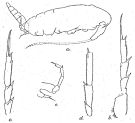 issued from : R.B.S. Sewell in Mem. Indian Mus., 1929, X. [p.70, Fig.25]. As Paracalanus parvus. Male: a, habitus (lateral right side); b, P2 (exopod); c, P3 (exopod); d, P4 (exopod); e, P5.
|
 issued from : T. Mori in The pelagic Copepoda from the neighbouring waters of Japan, 1937 (1964). [Pl.11, Figs.11-15]. As Paracalanus parvus. Female: 11, P5; 14, habitus (lateral (right side). Male: 12, P5; 15, P4.
|
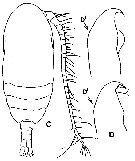 issued from : Y.-S. Kang in J. Korean Fish. Soc., 1996, 29 (3). [p.411, Fig.2, C-D]. Female (from Korean waters): C, habitus (dorsal); D, lateral view of anterior portion of the head. (D' = hump).
|
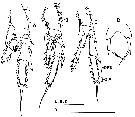 issued from : Y.-S. Kang in J. Korean Fish. Soc., 1996, 29 (3). [p.412, Fig.4]. Female: A-C, P2 to P4; D, P5. OPE: outer proximal edge; ODE: outer distal edge. Scale bars 0.2 mm.
|
 issued from : Y.-S. Kang in J. Korean Fish. Soc., 1996, 29 (3). [p.412, Table 1]. Morphological comparison of Paracalanus parvus, P. indicus and P. quasimodo based on the scheme of Bradford (1978).
|
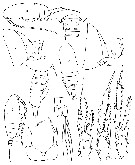 issued from : T.E. Bowman in Smithson. Contr. Zool., 1971, 96. [p.27, Fig.22, b-m]. Female (from E Florida): b-c, habitus (dorsal and lateral, respectively); d-e, posterior prosome and genital segment (lateral and dorsal, respectively); f, anal segment and caudal rami (dorsal); g-i, P2 to P4; j, P5. Female (from Gulf of Naples: k, habitus (lateral); l, posterior prosome and genital segment (lateral). Female (from Martinique): m, urosome and spermatophore (lateral). Nota: Prosome about 3.2 times as long as urosome. A1 reaching about to posterior margin of anal segment Dorsal hump only slightly or not at all developed, hence prosome not so high in relation to its lenth as in P. quasimodo. Genital segment, viewed dorsally, narrower than in P. quasimodo, lateral parts of posterior margin with row of minute spinules, without cluster of spinules above spermatheca. Spermatheca subelliptical, not narrowing distally.
|
 issued from : T.E. Bowman in Smithson. Contr. Zool., 1971, 96. [p.29, Fig.23, a]. Male (from E Florida): a, P5. Nota: identical to P. quasimodo except for the lack of spinules on the genital segment.
|
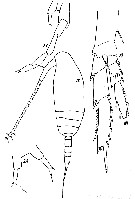 issued from T. Mori in Zool. Mag. Tokyo, 1929, 41 (486-487). [Pl. IV, Figs.17-20). As Paracalanus parvus. Female (from Chosen Strait, Korea-Japan): 19, P4; 20, P5. Male: 17, P5; 18, habitus (lateral).
|
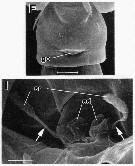 issued from : R.-M. Barthélémy in These Doct. Univ. Provence (Aix-Marseille I), 1999. [Fig.19, F, I]. Female (from 46°27.7'S, 168°04.2'E): F, external ventral view genital double-somite; I, internal dorsal view of the genital area. go = genital operculum; ed = egg-laying ducts; sr = seminal receptacles. Note in I the narrow proximal portion (arrowed) of seminal receptacles (conspicuously empties).
|
 issued from : K.S. Kesarkar & A.C. Anil in J. mar. Biol. Ass. UK, 2010, 90 (2); [p.404, Table 2]. Characteristics of females.
|
 issued from : K.S. Kesarkar & A.C. Anil in J. mar. Biol. Ass. UK, 2010, 90 (2); [p.407, Fig.5, E]. Female: E, P5.
|
 Issued from : W. Giesbrecht in Systematik und Faunistik der Pelagischen Copepoden des Golfes von Neapel und der angrenzenden Meeres-Abschnitte. – Fauna Flora Golf. Neapel, 1892, 19 , Atlas von 54 Tafeln. [Taf.9, Fig.17]. As Paracalanus parvus. Female: 17, A1 (ventral view).
|
 Issued from : W. Giesbrecht in Systematik und Faunistik der Pelagischen Copepoden des Golfes von Neapel und der angrenzenden Meeres-Abschnitte. – Fauna Flora Golf. Neapel, 1892, 19 , Atlas von 54 Tafeln. [Taf.9, Fig.9]. As Paracalanus parvus. Female: 9, A2 (posterior view).
|
 Issued from : W. Giesbrecht in Systematik und Faunistik der Pelagischen Copepoden des Golfes von Neapel und der angrenzenden Meeres-Abschnitte. – Fauna Flora Golf. Neapel, 1892, 19 , Atlas von 54 Tafeln. [Taf.9, Fig.34]. As Paracalanus parvus. Female: 34, Mx2 (anterior view).
|
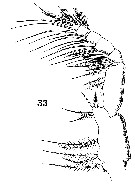 Issued from : W. Giesbrecht in Systematik und Faunistik der Pelagischen Copepoden des Golfes von Neapel und der angrenzenden Meeres-Abschnitte. – Fauna Flora Golf. Neapel, 1892, 19 , Atlas von 54 Tafeln. [Taf.9, Fig.33]. As Paracalanus parvus. Female: 33, Mxp (posterior view).
|
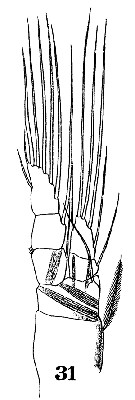 Issued from : W. Giesbrecht in Systematik und Faunistik der Pelagischen Copepoden des Golfes von Neapel und der angrenzenden Meeres-Abschnitte. – Fauna Flora Golf. Neapel, 1892, 19 , Atlas von 54 Tafeln. [Taf.9, Fig.31]. As Paracalanus parvus. Female: 31, P1 (anterior view).
|
 Issued from : W. Giesbrecht in Systematik und Faunistik der Pelagischen Copepoden des Golfes von Neapel und der angrenzenden Meeres-Abschnitte. – Fauna Flora Golf. Neapel, 1892, 19 , Atlas von 54 Tafeln. [Taf.9, Fig.11]. As Paracalanus parvus. Female: 11, P2 (anterior view).
|
 Issued from : W. Giesbrecht in Systematik und Faunistik der Pelagischen Copepoden des Golfes von Neapel und der angrenzenden Meeres-Abschnitte. – Fauna Flora Golf. Neapel, 1892, 19 , Atlas von 54 Tafeln. [Taf.9, Fig.25]. As Paracalanus parvus. Female: 25, P4 (posterior view).
|
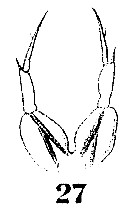 Issued from : W. Giesbrecht in Systematik und Faunistik der Pelagischen Copepoden des Golfes von Neapel und der angrenzenden Meeres-Abschnitte. – Fauna Flora Golf. Neapel, 1892, 19 , Atlas von 54 Tafeln. [Taf.9, Fig.27]. As Paracalanus parvus. Female: 27, P5. Nota: P5 is very similar from P. parvus as figured by Sars (1924-1925).
|
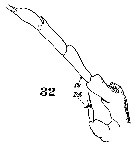 Issued from : W. Giesbrecht in Systematik und Faunistik der Pelagischen Copepoden des Golfes von Neapel und der angrenzenden Meeres-Abschnitte. – Fauna Flora Golf. Neapel, 1892, 19 , Atlas von 54 Tafeln. [Taf.9, Fig.32]. As Paracalanus parvus. Male: 32, P5 (posterior view).
|
 Issued from : W. Giesbrecht in Systematik und Faunistik der Pelagischen Copepoden des Golfes von Neapel und der angrenzenden Meeres-Abschnitte. – Fauna Flora Golf. Neapel, 1892, 19 , Atlas von 54 Tafeln. [Taf.9, Fig.5]. As Paracalanus parvus. Male: 5, A1 (ventral view).
|
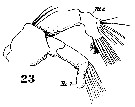 Issued from : W. Giesbrecht in Systematik und Faunistik der Pelagischen Copepoden des Golfes von Neapel und der angrenzenden Meeres-Abschnitte. – Fauna Flora Golf. Neapel, 1892, 19 , Atlas von 54 Tafeln. [Taf.9, Fig.23]. As Paracalanus parvus. Male: 23, A2 (anterior view).
|
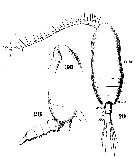 Issued from : W. Giesbrecht in Systematik und Faunistik der Pelagischen Copepoden des Golfes von Neapel und der angrenzenden Meeres-Abschnitte. – Fauna Flora Golf. Neapel, 1892, 19 , Atlas von 54 Tafeln. [Taf.6, Fig.28, 29, 30]. As Paracalanus parvusFemale: 28, thoracic somites 4+5 and urosome (lateral); 29, habitus (dorsal); 30, forehead (lateral). Nota: synonymy questionable.
|
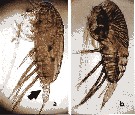 issued from : Y. Al-Yamani, V. Skryabin, A. Gubanova, S. khvorov & I. Prusova in Marine Zooplankton Practical Guide for the Northwestern Arabian Gulf, 2, 2011. [p.23, Fig.133] Female (from Kuwait): a, habitus (lateral). Male: b, habitus (lateral).
|
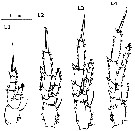 issued from : M. Khelifi-Touhami, R. Semroud, El H. Hamdi, M. Ounissi, A. Haridi, M. Néjib Daly & P. Aissa in Cah. Biol. Mar., 2007, 48. [p.335, Fig.4]. Female (from Tunisian waters): L1-L4, swimming leg 1 to leg 4.
|
 issued from : M. Khelifi-Touhami, R. Semroud, El H. Hamdi, M. Ounissi, A. Haridi, M. Néjib Daly & P. Aissa in Cah. Biol. Mar., 2007, 48. [p.336, Fig.5]. Female: a, P5; c, posterior prosome with P5 and genital segment (lateral). Male: b, P5.
|
 issued from : M. Khelifi-Touhami, R. Semroud, El H. Hamdi, M. Ounissi, A. Haridi, M. Néjib Daly & P. Aissa in Cah. Biol. Mar., 2007, 48. [p.336, Tableau 3]. Morphological comparison of Paracalanus parvus, P. indicus, and P. quasimodo (Modified from Bradford, 1978). B1: basipod 1; Ex3: exopod 3; Gns: genital segment; L2-4: legs 2-4. Authors: 1, Bradford (1978); 2, Bowman (1971); 3, Kang (1996); 4, Sewell (1929); 5, present study.
|
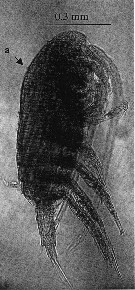 issued from : M. Khelifi-Touhami, R. Semroud, El H. Hamdi, M. Ounissi, A. Haridi, M. Néjib Daly & P. Aissa in Cah. Biol. Mar., 2007, 48. [p.334, Fig.3]. Paracalanus indicus female (from Gulf of Anaba, El Kala, N Tunisia): lateral view), a: dorsal hump. Nota: A1 shorter than body and extending beyond anal segment. Prosome 3 times longer than the urosome A dorsal hump slightly developed.
|
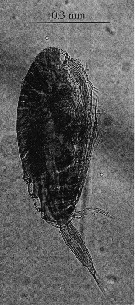 issued from : M. Khelifi-Touhami, R. Semroud, El H. Hamdi, M. Ounissi, A. Haridi, M. Néjib Daly & P. Aissa in Cah. Biol. Mar., 2007, 48. [p.333, Fig.2]. Paracalanus indicus male (from Gulf of Anaba, El Kala, N Tunisia): lateral view).
|
 Issued from : V.N. Andronov in Russian Acad. Sci. P.P. Shirshov Inst. Oceanol. Atlantic Branch, Kaliningrad, 2014. [p.89, Fig.23: 3]. Paracalanus indicus after Bradford-Grieve, 1994 . Mxp male
| | | | | Compl. Ref.: | | | Björnberg, 1973 (p.304, 388); Andronov & Maigret, 1980 (p.71, Table 2, 3); Almeida Prado-Por, 1983 (p.141, 142); 1985 (p.250); Kimmerer & McKinnon, 1985 (p.149); Greze al., 1985 (p.7); Madhupratap & Haridas, 1986 (p.105, tab.1); Jenkins, 1988 (p.233, Table 1, 2, 3, 4, fig.3, 4, 5, 6); James & Wilkinson, 1988 (p.249, Table 2, biomass, carbon ingestion); Kimmerer & McKinnon, 1990 (p.449); Almeida Prado-Por, 1990 (p.111); Yoo, 1991 (tab.1); McKinnon, 1991 (p.471); Eskinazi-Sant'Anna & Tundisi, 1996 (t.1,2); Suarez-Morales & Gasca, 1998 a (p.110); Lopes & al., 1999 (p.215, tab.1); Razouls & al., 2000 (p.343, Appendix); McKinnon & Duggan, 2001 (p.121); McKinnon al., 2003 (p.105, tab.2); Obuid Allah & al., 2005 (p.123, occurrence % vs metal contamination); Khelifi-Touhami & al., 2005 (p.149); Prusova & Smith, 2005 (p.75); Araujo, 2006 (p.173, Tab.3): Kang J.-H & al., 2007 (p.84, fig.3); Khelifi-Touhami & al., 2007 (p.329,figs.F,M, Rem.); Kang J.-H. & al., 2007 (p.82, fig.2, temporal variation vs. temperature & predation effect); McKinnon & al., 2008 (p.844: Tab.1, p.846: Tab.II, fig.7); Neumann-Leitao & al., 2008 (p.799: Tab.II, fig.6); Selifonova & al., 2008 (p.305, Tabl. 2); Shmeleva & al., 2008 (p.31, Table 1); Fernandes, 2008 (p.465, Tabl.2); Galbraith, 2009 (pers. comm., as indicans); Escribano & al., 2009 (p.1083, Table 1, 2, figs.6, 8, 10); Gusmao & McKinnon, 2009 (p.1101, sex ratios); C.E. Morales & al., 2010 (p.158, Table 1: ?); Lidvanov & al., 2010 (p.356, Table 3); Hernandez-Trujillo & al., 2010 (p.913, Table 2); Hidalgo & al., 2010 (p.2089, fig.2, 4, Table 2, cluster analysis); Zenetos & al., 2010 (p.397); Selifonova, 2011 (p.77, Table 1, alien species in Black Sea); Tutasi & al., 2011 (p.791, Table 2, abundance distribution vs La Niña event); Pillai H.U.K. & al., 2011 (p.239, Table 3, vertical distribution); Pérez-Aragon & al., 2011 (p.116, N excretion, as Paracalanus cf indicus); Glushko & Lidvanov, 2012 (p.138, Tableau 1, 3); Yañez & al., 2012 (p.295, natural mortality, growth rates); Hidalgo & al., 2012 (p.134, Table 2, 3, figs.5, 6, spatial distribution); Gubanova & al., 2013 (in press, p.4, Table 2); Lidvanov & al., 2013 (p.290, Table 2, % composition); Pino-Pinuer & al., 2014 (p.83, Table 1, 2, fig.3, 4, abundance variation vs time); Fierro Gonzalvez, 2014 (p.1, Tab. 3, 4, 5, occurrence, abundance) ; Escribano & al., 2014 (p.104, egg production, development vs temperature); Palomares-Garcia & al., 2018 (p.178, Table 1: occurrence); Yebra & al., 2019 (p.1, Table 4: length, width F, M) | | | | NZ: | 13 + 1 doubtful | | |
|
Distribution map of Paracalanus indicus by geographical zones
|
| | | | | | | | | | | | | | |  Issued from : P. Hidalgo, R. Escribano, M. Fuentes, E. Jorquera & O. Vergara in Progr. Oceanogr., 2012, 92-98. [p.140, Fig.5. Spatial distribution of a dominant copepod species (ind m3) found off central-southern Chile in summer 2009. Abundance are mean values in the upper 0-200 m layer. Issued from : P. Hidalgo, R. Escribano, M. Fuentes, E. Jorquera & O. Vergara in Progr. Oceanogr., 2012, 92-98. [p.140, Fig.5. Spatial distribution of a dominant copepod species (ind m3) found off central-southern Chile in summer 2009. Abundance are mean values in the upper 0-200 m layer.
Nota: The upwelling region of central-southern Chile is located at mid latitudes within the eastern boundary upwelling region of Chile and Peru. |
| | | | Loc: | | | sub-Antarct. (SE Pacif.), Brazil (S, Cabo Frio, Recife), Caribbean Sea, off C. Hatteras S, Morocco-Mauritania, ? Canary Is., Medit. (Alboran Sea, Gulf of Annaba, El Kala shelf, G. of Napoli, Bizerte, W Black Sea, Sebastopol), Safâga, Red Sea, Arabian Sea, Arabian Gulf (Kuwait), Indian, Bay of Bengal, Andaman Sea (Batten Island), ? Straits of Malacca, Indonesia (SW Sulawesi: sensu lato.2), China Seas (South China Sea, Hong Kong, Yellow Sea), ? Taiwan (SW, W), Japan, Korea, Oregon, California, Baja California (Bahia Magdalena, La Paz), Australia (Port Philip Bay, Melbourne, Great Barrier, Shark Bay, Noth West Cape, Darwin Harbour), New Zealand, Cape Farewell - Taranaki Bight, Galapagos-Ecuador, Chile (N-S, off Valparaiso, off Santiago, Conception)
Data from Cornils & Blanco-Bercial (2013): sl.2: 05°11'S; 143°16'W; sl.3:05°07'S; 119°21'E. | | | | N: | 69 ? | | | | Lg.: | | | (29) F: 0,76; M: 0,74; (86) F: 0,97-0,84; 1,14-1; (91) F: 1,2-0,7; M: 1,2-0,8; (131) F: 1,3-0,70; M: 1,4-0,74; (196) F: 1,09-0,84; M: 1,39-0,9; (435) F: 0,95-0,85; M: 1,02-0,85; (985) F: 0,66-0,99; M: 0,88-1,05; (1047) F: 0,85; (1085) F: 0,85-0,95; M: 0,85-1,02; (1225) F: 0,85-0,95; M: 0,85-1,02; {F: 0,66-1,30; M: 0,74-1,40}
The mean female size is 0.906 mm (n = 16; SD = 0.1780) and the mean male size is 0.999 mm (n = 15; SD = 0.2104). The size ratio (male : female) is 1.090 (n = 8; SD = 0.0799). The sex ratio (female : male) is 1 (except in a sampling). | | | | Rem.: | Sampling depth (sub-Antarct.) : 150 m.
Certain confusions are possible with Paracalanus parvus and Paracalanus quasimodo, hence the locality records to confirm in the Atlantic Ocean.
For Bradford (1978, p.137) there is some doubt that New Zealand specimens and those considered by Bowman (1971) are conspecific. Nevertheless this name is retained pendig closer examination of P. indicus on a world-wide scale.
R. Stephen, 2007 : Data sheets of NIO, Kochi, India (on line). | | | Last update : 19/06/2023 | |
| | | | Many P. indicus were identified in the position of lon: -115.7725; lat: 13.7653 and probably deeper of epipelagic area to 2000 m depth during April 2011 in the Malaspina expedition. But due to broken legs could be confusion with P. parvus as well | |
|
|
|
 Any use of this site for a publication will be mentioned with the following reference : Any use of this site for a publication will be mentioned with the following reference :
Razouls C., Desreumaux N., Kouwenberg J. and de Bovée F., 2005-2025. - Biodiversity of Marine Planktonic Copepods (morphology, geographical distribution and biological data). Sorbonne University, CNRS. Available at http://copepodes.obs-banyuls.fr/en [Accessed November 28, 2025] © copyright 2005-2025 Sorbonne University, CNRS
|
|
 |
 |





































